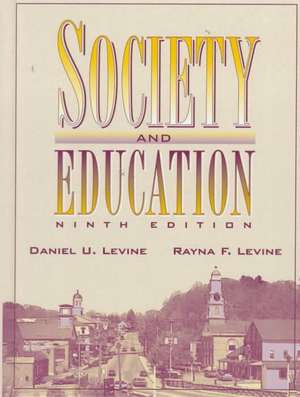Society and Education
Autor Daniel U. Levine, Rayna F. Levineen Limba Engleză Paperback – 19 dec 1995
- The Ninth Edition of Society and Education continues its tradition of incorporating forward-looking material. Reflecting both recent developments and long-range trends involving the relationships between education and other social institutions, it continues to provide a balanced treatment of controversial issues — in sufficient depth to help students understand complicated and important topics to current and future teachers and administrators. While systematically including historical background material on major topics involving schools in the social order, it simultaneously emphasizes contemporary developments and is very up-to-date with regard to research, legislation, theoretical perspectives, and other matters. Every chapter has been revised to include new material and updated information. Topics that receive expanded treatment include immigration, multicultural education, evolution of the inner city, rural schools, and movement toward systematic reform and national standards.
Preț: 613.34 lei
Preț vechi: 757.21 lei
-19% Nou
Puncte Express: 920
Preț estimativ în valută:
117.38€ • 127.45$ • 98.60£
117.38€ • 127.45$ • 98.60£
Cartea nu se mai tipărește
Doresc să fiu notificat când acest titlu va fi disponibil:
Se trimite...
Preluare comenzi: 021 569.72.76
Specificații
ISBN-13: 9780205189359
ISBN-10: 0205189350
Pagini: 624
Dimensiuni: 178 x 235 x 30 mm
Greutate: 1.56 kg
Ediția:9Nouă
Editura: Pearson Education
Colecția Merrill
Locul publicării:Upper Saddle River, United States
ISBN-10: 0205189350
Pagini: 624
Dimensiuni: 178 x 235 x 30 mm
Greutate: 1.56 kg
Ediția:9Nouă
Editura: Pearson Education
Colecția Merrill
Locul publicării:Upper Saddle River, United States
Cuprins
1. Socioeconomic Trends and the Social Class Structure.
The Social Class Hierarchy.The Occupational; Structure.Perspectives on Social Structure.Subcultures of the Social Classes.Development of a Big-City Underclass.Economic, Social, and Demographic Changes.Conclusion.
2. Educational Selecting and Sorting in Postindustrial, Metropolitan Society.
Sorting and Selecting in the Educational System.Additional Topics Involving Sorting and Selecting.The Crisis in Sorting and Selecting.Metropolitan Evolution.Urban Redevelopment and Renewal.Recent Positive Developments in Metropolitan Evolution.Conclusion: The Crisis in Sorting and Selecting.
3. Problems of Children and Youth in Differing Social Class Environments.
Evolution of the Child-Nurturing Modern Family.Working-Class Environments.Underclass Environments.Middle-Class Environments.Implications for Education.Social Class Environments and Classroom Social Control.
4. Home Environment, the Family, and Cognitive Development.
Importance of Early Environment.Home Environment, Cognitive Development, and Achievement.Recent Trends in the Family and Youth Development.Problems Related to Family Evolution.The Postnuclear Family Adrift on a Sea of Self-Fulfillment.Parental Involvement and Cooperation with the School.Conclusion.
5. The Peer Group.
The Nature and Importance of the Peer Group.Functions of the Peer Group.The Adolescent Peer Group and Problem Behavior.The Growing Influence of the Peer Group.The Peer Group and the Family.The Peer Group and the School.The Peer Group and the Community.Decline of Urban Playgrounds and Open Spaces.Out-of-School Services for Children and Adolescents.Conclusion.
6. The Transition from Adolescence to Adulthood.
Youth as a Separate Stage of Life.Historical Views of Youth.Size of the Youth Group.The Values and Attitudes of Youth.Suicide.Homicide.Youth and Employment.The Transition from School to Work.Delinquency and Violence Among Juveniles and Young Adults.Drug Abuse.Teen Pregnancy.Community and National Service.Personal Capital/Educational Equity Accounts.Schools and Other Institutions in a Constructive Program for Youth.Conclusion.
7. Mobility and Education.
The Nature and Amount of Social Mobility.Education, Opportunity, Mobility, and Earnings.Education and the Socioeconomic Power Structure: The Neo-Marxist and Revisionist Critiques and Critical Pedagogy.Conclusion.
8. Low-Status Students and Compensatory Education.
Reasons for Poor Performance.Implications for Instruction.Students and Schools in Concentrated Poverty Communities.The Status of Compensatory Education.Comprehensive Ecological Intervention.Coordinating Schools with Other Agencies.Social Policy and Compensatory Education.Financing of Central-City Schools.Conclusion.
9. Desegregation.
Status of School Desegregation.Desegregation Goals and Obstacles.Instructional Improvement Components in Desegregation Plans.Effects and Outcomes of Desegregation.Urban Schools and Desegregation.Housing and School Desegregation.When Inner-City Families are Relocated in the Suburbs.Federal Initiatives on Housing Desegregation.Conclusion.
10. Cultural Pluralism and Minority Education.
Recent Immigration Patterns and Developments.Pluralism.African Americans and Education.Hispanic Americans and Education.Asian Americans and Education.Native Americans (American Indians and Eskimos).Appalachian Students.Employment of Minority Teachers.Adapting Instruction in Accordance with Culture and Learning Styles.Constructive Cultural Pluralism and Multicultural Education.Conclusion.
11. Women and Education.
Work Roles.Occupational Status.The Earnings Gap.The Continuing Plight of Displaced Homemakers.Sex Differences in Achievement and Ability.The Education of Women.Interventions to Promote Sex Equity.Recent Directions in Feminism.Conclusion.
12. Additional Topics Focusing on Educational Equity.
Computers and Equity in Elementary and Secondary Schools.Rural Education.Nonpublic Schools and Public Policy.
13. School Reform and Effectiveness.
Achievement Levels and Trends in Elementary and Secondary Schools.National Reports and Developments Since 1983.Participation of External; Organizations in Improvement and Reform.Recent School Choice Proposals and Developments.Manifest/Latent Functions and Unforeseen Consequences.Effective Schools Research.Research on Effective Instruction.Exemplary Approaches for Improving Instruction.Accomplishing School Improvement and Reform.At-Risk Students and Dropouts.Crucial Issues in Moving Further toward School Reform.Conclusion: School Reform and the Crisis in Metropolitan Society.
Caracteristici
- “Suggestions for Further Reading” provide students with valuable references and resources to supplement text reading.
- Conclusion section at the end of every chapter enables students to reflect on material discussed within every chapter.
Caracteristici noi
- Hundreds of updated references ranging from “classic” studies and papers to current citations and research summaries.
- Presents and contextualizes concepts surrounding the growing diversity in US schools and society. Topics treated comprehensively with reference to diversity include pluralism, bilingual education, immigration, and issues regarding learning styles.
- Final chapter provides a comprehensive, up-to-date summary and analysis of topics involving school reform and effectiveness.
